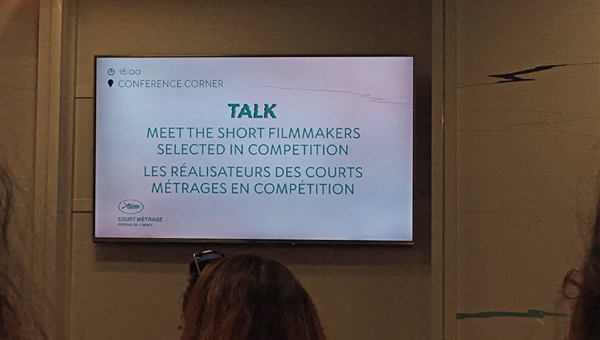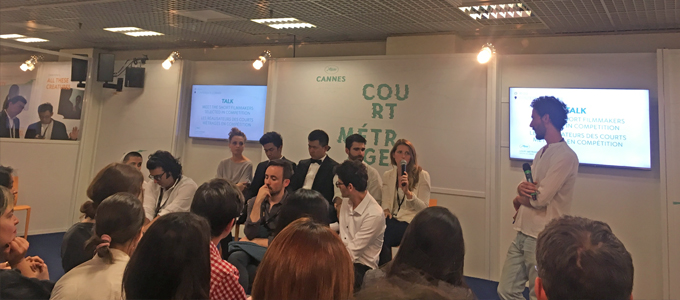On the last Friday afternoon of the Cannes Film Festival, a ‘Meet the Directors’ Press Conference was held with all of the short film directors competing for the Palme d’Or in this year’s festival. This was conducted in the shorts film corner in the Marche du Film inside the stunning Palais du Festivals. Despite having almost ten rows of seating spanning the length of the room, the outskirts of the conference was teeming with people, all hoping to catch a glimpse of the directors and filmmakers and hear about their work. Each director took it in turn, to speak about their process, concepts and what they hoped to achieve with their work, including struggles and successes:
Logan George and Celine Held: CAROLINE / USA
Husband and wife Logan George and Celine Held co-wrote and co-directed the short CAROLINE. Amongst the eight contenders nominated for the Short Film Palme d’Or, the film is based on three true stories about mothers facing charges for leaving their children in hot cars during summer. It reflects conflicting issues in America such as childcare issues, lack of access to female contraception/healthcare and the economy. In most cases, this action is taken due to the lack of childcare provided in the country. There were three main characters: Caroline, Brook and Sally Falk, who were aged 6, 4 and 1 when the duo filmed the short. Only around 2-4 people were made known to the children so that it was kept ‘small-world’ and was not too overwhelming. For children to give convincing, honest performances they needed to trust and listen to the few people they knew on set. Both Held and George had specific roles during the process of filming; while Held worked with the kids on their character and performances, George worked with the director of photography which balanced out their work on set. The two complement each other as one does all the research and completes the first draft and the other edits the final draft and reworks the ending. The concept of the film was to make viewers feel trapped with the children, accentuating the heat of the car, subtly panning to them fidgeting and sweat dripping off their cheeks. They discussed how it was essential to stick to the roots of the film, identify its purpose and create ‘the most concentrated film possible’. For a short film, this is entirely necessary to convey the right message to the audience.
Caroline Trailer from ELO films on Vimeo.
Oren Gerne: GABRIEL / France
Directed by Oren Gerner, GABRIEL is a 12 minute short which explores a teenager’s journey through the forest after a violent incident separates him from his group of classmates. As he wanders deep into the woods, he drifts away from the search crew. The film does not precisely have a beginning or an end; instead, Gener stated ‘the film mainly focused on the realistic search of a mental and conscious journey’ of the main character. The film emphasises the ‘passion of finding something and the desire to be found’. There is no definite ending to the film but it looks at how you can get lost in a forest and in life. It reaches to one’s inner voice. Gerner spoke about how the film became a transition from searching to finding, and how we all hope to be found. It becomes a mental search and ‘the audience gets lost with him’ within the woodlands. As an Israeli, he said that shooting in France was a unique experience as they have a different mentality and pace during filming which contributed to the atmosphere of the short. The name of the film also has a particular inference, as Gabriel is a religious icon, an angel, which drives a theological context.
Raymond Gutierrez: JUDGEMENT / Philippines
This short is about violence against women: when asked what Raymund Ribay aimed for with the short, he explained ‘this is a common concern in the Philippines, especially in my neighbourhood. Personally, I’m very close to my mother and sister and being taught since an early age to respect women in my life I was driven to acknowledge this lack of concern people have towards violence against women’. Ribay finds it hard to ignore this issue, and he aimed to address it through filmmaking. He states ‘ I’m not an eloquent speaker, and film is the ultimate outlet for me to address such concerns’. A year of research was done before production began, including 8-months pre-production. Ribay spoke to many abused victims, and this helped him understand abused women’s perspective and experiences. People were afraid to fight these injustices, including the expensive and impractical justice system in his country. In the Philippines, he notes, it is considered ‘family first’ in most situations, and causes too many loopholes in the justice system. During location-searching, he found that by getting to know the locals, it was understood this was a communal subject people objected to and the honesty around his research allowed people to trust him and the medium he was using, to tell the truth of these stories. He stated in his closing remarks ‘whatever we experience in reality must be shown through the craft of filmmaking to help society learn about issues concerning our world’.
Charles Williams: ALL THESE CREATURES / Australia
The thirty-six-year-old from Sydney has won the Palme d’Or in the short film category at Cannes. Shooting on 16mm film, Charles William vaguely planned his script to adapt to whoever would suit the role of the main protagonist. He wanted to find ‘maturity and innocence which would come across visually’. William gave himself a diverse selection of people who would be eligible to play his main characters. ‘I left it open; the gender and race’. He didn’t believe race or gender restrictions would matter regarding the film’s narrative, however, William took into account his lead actor’s background and experience to develop his film’s plot and to accurately represent the Ethiopian culture. The casting was done broadly, and in the end, a 12-year-old child and mum were chosen who had Ethiopian descent, and a father with a Sudanese background. Williams worked on the script about the actor’s heritage and experiences, allowing the character to naturally develop throughout the film. The type of film used allowed for the film texture to feel more natural, as fewer mistakes were made and allowed the issues and thoughts to be displayed clearly. In terms of the links between bugs and memories, when we are younger, we see insects with some compassion and level of understanding without fully comprehending what it means to be unconditionally kind. The cicadas provide a calming melody to the thought process. When discussing the deeper issues of the short, Williams comments on how the domesticated violence in the film does not cause this automatic realisation, but instead that ‘the father was not accepting of his feelings until he hits the animal. He realises these actions have caused suffering to others’. Equally, he considers how we can’t fix people and don’t always have the answers – it is not a power we possess. There is a complex balance of a young boy struggling to comprehend the darkness growing in his father, perhaps his memory linking it to the memories of the bugs, and how he cares yet worries for a parent he cannot help.
All These Creatures – Trailer from Charles Williams on Vimeo.
Saeed Jafarian: TARIKI / Iran
The premise of the film was to make the concept open to interpretation, but also to help understand the situation in Iran. Jafarian spoke about how women do not leave their homes at night, and it is rare to even see a man out past midnight in most small towns. In the film, to have a woman wandering around late is a terrifying prospect. Having this man appear in the darkness with a growling presence would be a shock to any individual. The script is written by a woman, with female-centric lines putting a spin on a unique perspective. The entire situation is unspecified, dangerous and sadly the film will not change the opinion of those in Iran, despite having not being aired in the country yet. Her boldness and defiance of these expectations are riveting, and her confrontations are passionate; a level of intensity in the air which becomes electrifying.
Wei Shujan: ON THE BORDER / China
The director spoke of his intentions to visualise the experiences of life on the border between China and Korea. It is a look into the daily lives of those living there. Shunjun comments on a question about broken down machines, discussing how they are left in run-down areas, with little hope of repair but with much potential – just like the citizens living there. There are also notable shots that look at the generational divide, in which he states: ‘I notice this with my father, there is a generational issue in life and in the film. The child wants to leave and travel, but the father wants him to save for an education’. He speaks in more detail about people never leaving the area, and you can feel trapped with them. Time and investment were spent looking into these concepts, as he noted that he wanted to ‘craft something that was immediately engaging’ which demonstrates the detail put into the film and the precision needed to accurately represent the culture. Shujun closed this with a discussion of bringing the reality of the situation to the film’ in his justification of using this medium to tell this well-known story.
Marta Pajek: III / Poland
Marta began her discussion about the purpose of the film’s title and how this links into her other work on the topic. III is part of three films evidently, and these stories are intended to be told through sound and expression. She notes: ‘I wanted it to be sensual and tactile… It figures the role of perspectives between two poles’ which connotes the logic behind the abstract workings of the only animated short. This brief and contemporary statement addresses the form of the film, acknowledges the two most purposeful feelings we all hopefully came away with and how we identify with the characters on a personal level. She comments on the purpose of III as a love-thriller, and there is a frightening uncertainty about her work. However, Pajek also needed a balance for the reasoning behind the commotion and wanted something to resonate with us. There needs to be a fluid, unclear comments of reasoned feelings.


